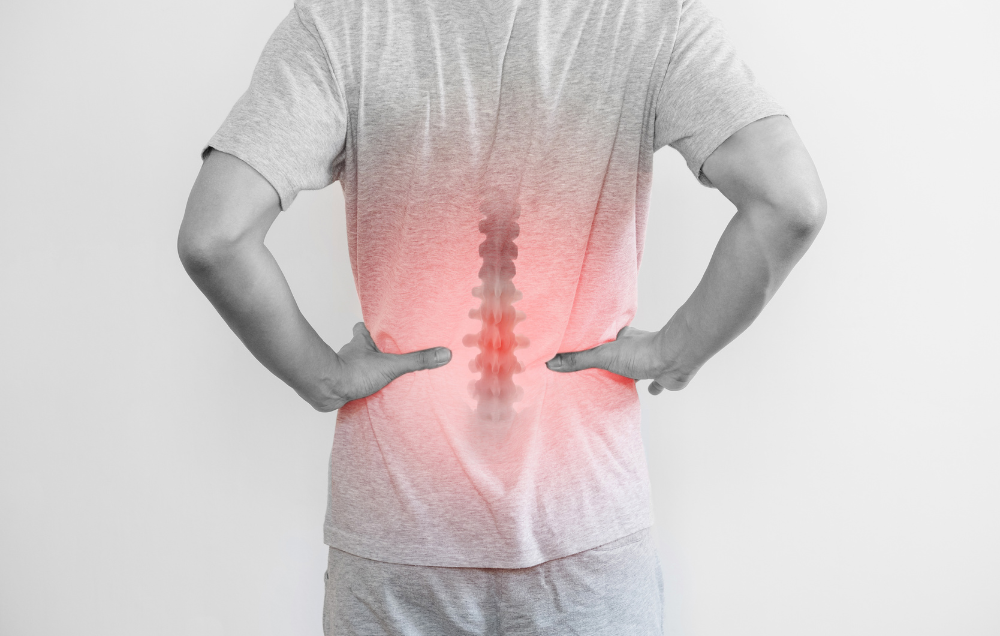Contents
If you spend your workday sitting at a desk or lifting heavy materials, you may develop pain in your back or your legs due to spinal compression. Many back problems are caused by repetitive movements, overuse or sitting in the same position for long periods. When heat and cold therapy or manual physical therapy techniques don’t help, nonsurgical spinal decompression therapy may provide some relief.
There is mixed clinical evidence that nonsurgical spinal decompression therapy can effectively help reduce back pain. Many of our patients report that it’s helpful. However, it’s not for everyone.
This article will describe what you can expect during a spinal decompression therapy session and who can benefit from this treatment.
How do physical therapists perform spinal decompression therapy?
Your physical therapist will ask you to lie down on a traction table, which straps around your pelvis and trunk or your neck and upper back. They’ll manually adjust the table to reduce pressure in the affected part of your spine. This can allow your back to naturally reposition a herniated or bulging disc. It will also bring an influx of healing nutrients and other substances into the compressed part of your spine.
What else can I expect during a spinal decompression therapy session?
Your physical therapist will likely teach you some exercises you can do at home to maintain flexibility in your back and keep it from hurting. They may do an ergonomic evaluation with you to help you minimize the pressure you put on your back during the day. They can recommend strategies and equipment that will help, like a brace or a back support for your chair. Standing up to stretch your legs and your back every couple of hours during the workday can relieve a lot of pain from sitting for too long.
What conditions does spinal decompression therapy help with?
Spinal decompression therapy can reduce pain in the hips, knees and joints in addition to the spine. There are some common issues that it’s particularly helpful with. It’s usually combined with other therapies and treatments for the most effective pain relief.
Spinal decompression therapy can help improve the following conditions:
- Bulging or herniated disc — A bulging disc occurs when the spine repeatedly puts pressure on one side of a disc. Over time, the jellylike center of the disc may begin to bulge outward. When a bulging disc breaks open and puts pressure on a nearby nerve, it’s called a herniated disc.
- Degenerative disc disease — Over time, the gel core of the spinal discs starts to wear down and dry up, leaving less cushion between the vertebrae within the spine. This is a naturally occurring condition that is often triggered by age or repetitive movement in the spine. It can cause a pinched nerve and put pressure on other discs.
- Sciatica — Sciatica can be caused by a number of spine conditions (such as the two mentioned above). It occurs when the large sciatic nerve in your spine that runs from your lower back all the way down to your calves is pinched or compressed. Sciatica can cause pain, tingling and numbness anywhere from your lower back, down through your buttocks and hamstrings, and into the backs of your lower legs.
- Pinched nerves — A nerve that gets compressed or pinched can cause numbness, pain or tingling.
Who should avoid spinal decompression therapy?
There are some situations when spinal decompression therapy isn’t recommended. If you’re pregnant, if you have fused vertebrae, or if any of your vertebrae are broken, you shouldn’t try spinal decompression therapy. Tell your physical therapist about any back surgeries you’ve had in the past: If you have an artificial disc or other implant in your spine, or if you’ve had a failed back surgery, you shouldn’t try spinal decompression therapy.
There are several conditions that can compromise the integrity of your spine, like ankylosing spondylitis, spinal stenosis and osteoporosis. If you have a condition that weakens or affects your vertebrae, you might not be a good candidate for spinal decompression therapy. Mention any conditions you have that can affect the spine or your bones when you discuss treatments with your physical therapist.
What are the alternatives to spinal decompression therapy?
Sometimes back pain can go away on its own, or with heat and cold therapy and behavior modifications. At Lattimore Physical Therapy, we provide TENS (transcutaneous electrical neuromuscular stimulation), which promotes healing by applying gentle electrical stimulation to the affected area. There are manual therapy techniques like joint and tissue mobilization that can reduce pressure on the lower back. Our PTs can recommend exercises to strengthen your back and make it more flexible, relieving pain and pressure in the lower back.
If nonsurgical spinal decompression therapy and these other methods don’t work, you may eventually need surgery. There are several different surgical methods that can decompress or relieve pressure in the spine.
Try spinal decompression therapy for back pain at Lattimore PT
If you’ve been suffering from lower back pain, seeking treatment now can reduce the likelihood that you’ll need back surgery later. Our PTs are skilled with spinal decompression therapy and alternatives that are safer for people who can’t have this type of therapy. Many of our physical therapists have a Certification in Orthopedic Manual Physical Therapy (COMT), so you’re in good hands.
There may be more than one condition or problem causing your back pain. We can help narrow down what’s causing your back pain and create a personalized treatment plan that’s safe and effective for you.
Contact our team today for more information or to schedule an initial appointment.



